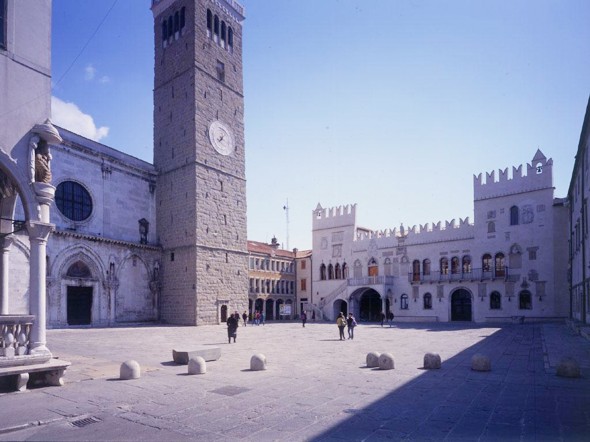
|
Municipality of Koper-Capodistria is a central municipality
of the coastal region in south western Slovenia. One of
eleven urban municipalities, it covers a total area of 311
square kilometres and has a population of 46,757 people
(2002) living in 105 settlements. This historic city is
located only 20 kilometres south of Trieste, Italy and about
30 kilometres north of the Croatian border.
The population of Koper is mainly Slovene, but there is also
an active Italian minority. Due to the official bilingual
policy in the area, the Italian language and all other
cultural values of the Italian national minority are
preserved. Koper is not only a trade and industrial centre
of Slovene Istria, but in many ways also a cultural centre.
The town has many schools, ranging from elementary and
secondary schools to higher education institutions and
faculties such as the University of Primorska, which was
established in 2003.
Koper occupies an island close to the shore which has
variously been called Kozji otok (Goat's island), Justinian
town and, by Slovenes, Koper. The city enjoyed an important
position within the Venetian Republic, hence its clear
Italian architectural influences (eg Almerigogna Square, one
of the most magnificent Venetian Gothic places in Koper).
The town has been linked to the mainland since 1825. The
newer part of the town has the air of a modern urban
settlement with apartment blocks, contrasting with the
typical coastal town appearance of the 'island' part. |

|
There are numerous architectural monuments in the old part
of the town - from the Rotunda, with its typical Romanesque
exterior, to the Praetorian Palace with the town's coat of
arms and busts of Koper's important citizens. In the central
square are a loggia, which has preserved the charm and
character of its 15th-century origins, and the cathedral (the
Diocesan seat) with a sarcophagus of St Nazarus and
paintings by Vittorio Carpacci. The Belgramoni-Tocco Palace
houses the Koper Regional Museum.
Koper is a member of the Slovene Association of Historic
Towns.
The Social Activities Office of Koper-Capodistria Urban
Municipality acts as a governance and professional body
responsible for education, culture, sport, research, health
and social care and the prevention of drug addiction. It
oversees the activities of cultural public institutes and
prepares acts regulating their status and organisation.
Operating alongside Koper-Capodistria’s municipal
institutions are a number of important national cultural
institutions, including the Regional Archives Koper.
|
|
|
Koper (Capodistria in Italian), pop. 25,000, is a coastal
municipality and the largest commercial port in Slovenia, on the
Adriatic Sea coast. Sights in Koper include 15th century
Praetorian Palace in Venetian Gothic style, the 12th century
Carmine Rotunda church, and the Cathedral of St Nazarius with its
14th century tower.
Koper history
Koper rose from an ancient settlement built on an island in the
southeastern part of the Gulf of Koper in the northern Adriatic.
In the time of Ancient Greece, the town was known as Aegida, later
it became known by its Latin names Capris, Caprea, Capre or
Caprista, from which the modern Slovenian name stems from.
In 568, Roman citizens of nearby Tergestum (modern Trieste) fled
to Koper due to an invasion of the Lombards. In honour of the
Byzantine emperor Justinian II, Koper was renamed to Justinople.
Later, Koper was under both Lombard and Frankish rule.
Trade between Koper and Venice was registered since 932. In the
war between Venice and Germany (Holy Roman Empire), Koper was on
the German side, and was in result awarded by town rights, granted
in 1035 by the emperor Conrad II. Since 1232, Koper belonged to
the patriarch in Aquilea, and in 1278 it joins the republic of
Venice.
Koper grew to become the capital of Venetian Istria and was
renamed to Caput Histriae, "head of Istria" (from which its modern
Italian name Capodistria stems from).
Since the 8th century, possibly even since 6th century, Koper was
the seat of bishop. In 1828, it was merged the diocese of Trieste,
but was restored after World War II to reflect the new
geopolitical boundaries as it became part of Yugoslavia, before
Slovenian independence in 1991.
|
|